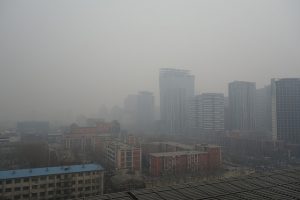Beijing, the capital of China, is considered by many the current most industrious city of its nation. It is also one of the most polluted cities, which is largely related to its immense resource consumption and waste output correlated with increased industry.
In Beijing, air pollution is one of the forms of pollution that has the most widespread effects. Most of the air pollution produced, referred to also as a “haze problem,” comes from:
- coal burning
- vehicle exhaust
- climate and geographical environment
- crop stubble burning
- fireworks (Wang & Liu, 2014, 1267).
Air pollution that is from coal burning is made up of
- fine ash
- smoke
- flue gas
and contributes to the haze that hangs over cities like Beijing where industry is high (Chen et al., 2014, p. 739; Wang and Liu, 2014, p. 1265).
Coal and other fossil fuels are the main source of energy used to provide heat in the winters. The burning of coal for this energy increases haziness in Beijing, especially during the winter months. Coal is also used largely by factories, adding to the cloud created by the residential areas (Wang & Liu, 2014, 1269). Nitrogen levels caused by human outputs are higher in densely populated cities like Beijing (Xian et al, 2016, 17692).
Further, vehicle use adds to the haze, which is physically contained in a concentrated area by geographical formations around Beijing (Wang & Liu, 2014, 1274). It is easy to draw the conclusion that increased greenhouse gas emissions have been correlated with the increase of industry in China.

An image of the very prevalent air pollution haze in Beijing.
Eimoto, K. (Photographer). Beijing Air Pollution…
Bibliography:
Chen, J., Liu, G., Kang, Y., Wu, B., Sun, R., Zhou, C., & Wu, D. (2014). “Coal utilization in China: environmental impacts and human health.” Environmental Geochemistry & Health, 36, 735-753. doi: 10.1007/s10653-013-9592-1.
Eimoto, K. (Photographer). (2014, February 22). Beijing Air Pollution… Sanlutin, Beijing, China: Flickr. https://www.flickr.com/photos/kentaroiemoto/12691254574.
Wang, K., & Liu, Y. (2014). Can Beijing fight with haze? Lessons can be learned from London and Los Angeles. Natural Hazards, 72, 1265-1274. doi: 10.1007/s11069-014-1069-8
Xian, C., Ouyang, Z., Lu, F., Yang, X., & Yanmin, Li. (2016). Environmental science and pollution research international: Quantitative evaluation of reactive nitrogen emissions with urbanization: a case study in Beijing megacity, China. Environmental Science and Pollution Research International, 23(17), 17689-17701. doi: 10.1007/s11356-016-6961-1
